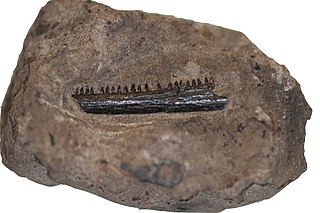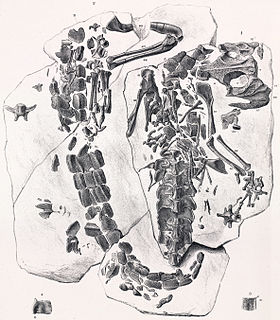
Goniopholis is an extinct genus of goniopholidid crocodyliform that lived in Europe and Africa during the Late Jurassic and Early Cretaceous. Being semi-aquatic it is very similar to modern crocodiles. It ranged from 2–4 metres in length, and would have had a very similar lifestyle to the American alligator or Nile crocodile.

Bothriospondylus is a dubious genus of neosauropod sauropod dinosaur. It lived during the Late Jurassic.
Goniopholididae is an extinct family of moderate-sized semi-aquatic crocodyliforms superficially similar to living crocodiles. They lived between the Early Jurassic and the Late Cretaceous.

Alligatorellus is a genus of atoposaurid crocodyliform found in France that was related to Atoposaurus.

Atoposauridae is a family of crocodile-line archosaurs belonging to Neosuchia. The majority of the family are known from Late Jurassic to Early Cretaceous marine deposits in France, Portugal, and Bavaria in southern Germany. The discovery of the genus Aprosuchus, however, extends the duration of the lineage to the end of the Cretaceous in Romania.

Pholidosauridae is an extinct family of aquatic neosuchian mesoeucrocodylian crocodylomorphs. Fossils have been found in Europe, Africa, North America and South America. The pholidosaurids first appeared in the fossil record during the Bathonian stage of the Middle Jurassic. Jouve & Jalil (2020) described postcranial material of a pholidosaurid from the Paleocene (Danian) of Ouled Abdoun Basin (Morocco), representing the most recent record of the family. The authors also reinterpreted putative Maastrichtian dyrosaurid Sabinosuchus as a pholidosaurid, and argued that at least two independent pholidosaurid lineages reached the Maastrichtian, among which one survived the Cretaceous–Paleogene extinction event. Before the publication of this study it was thought that the family became extinct during the Late Turonian stage of the Late Cretaceous.

Hoplosuchus is a genus of crocodylomorph belonging to Protosuchidae. It is so far only known definitely from one specimen, a skeleton collected from sandstone of the Upper Jurassic-age Morrison Formation rocks at Dinosaur National Monument, Utah, during road construction. The individual was small, approximately 20 centimetres (7.9 in) long, although it may have been very young. It is the basalmost crocodyliform of the Morrison Formation, as suggested by such attributes as still having antorbital fenestrae in the skull. The limbs were relatively long, suggesting that the animal was terrestrial. Two rows of bony scutes ran down the back. The crowns of the teeth are not well preserved, so the diet cannot be determined with certainty. Given its small size, it probably ate insects and small vertebrates; it may have been carnivorous or omnivorous.

Atoposaurus is an extinct genus of crocodylomorph. It is the type genus of the family Atoposauridae. Fossils have been found that were Late Jurassic in age from two distinct species in France and Germany.
Eutretauranosuchus is an extinct genus of goniopholidid crocodyliform. E. delfsi is the only known species within the genus.
Neosuchia is a clade within Mesoeucrocodylia that includes all modern extant crocodilians and their closest fossil relatives. It is defined as the most inclusive clade containing all crocodylomorphs more closely related to Crocodylus niloticus than to Notosuchus terrestris. Neosuchia is very diverse and may be polyphyletic, as the clade has undergone many revisions since it was first named in 1988. Neosuchians first appear in the Early Jurassic with the earliest known goniopholid Calsoyasuchus, which lived during the Sinemurian and Pliensbachian stages.

Cteniogenys is a genus of choristodere, a morphologically diverse group of aquatic reptiles. It is part of the monotypic family Cteniogenidae. The type, and only, species, C. antiquus, was named in 1928 by Charles W. Gilmore.

Montsecosuchus is an extinct genus of atoposaurid crocodylomorphs. It is the replacement generic name for Alligatorium depereti, which was described in 1915 from the Montsec Lithographic Limestone quarry of Spain. Fossils found from this locality are from the Early Cretaceous, being Upper Berriasian-Lower Valanginian in age, belonging to the La Pedrera de Rúbies Formation While many publications concerning atoposaurids after 1915 have included mentions of A. depereti, none has offered a redescription or revision of the species, though some recognized that great differences existed between it and other members of the genus. In these publications, the skull of A. depereti was shorter in relation to body length than any other species of Alligatorium, and this may have been evidence for the genetic distinction of the species, although no replacement name was proposed. However, better preparation of the holotype specimen MGB 512, a nearly complete articulated skeleton embedded in a limestone matrix now housed in the Museu de Ciències Naturals de Barcelona, allowed for a revision of the species in 1990 in which the name Montsecosuchus was first used.

The Valtos Sandstone Formation is a Middle Jurassic (Bathonian) formation found in the Inner Hebrides of Scotland. It is the thickest member of the Great Estuarine Group. The lithology consists of sets of approximately 6 metre thick cross bedded sandstone, capped by thin shelly limestones containing bivalves of the genus Neomiodon Dinosaur remains are among the fossils that have been recovered from the formation, although none have yet been referred to a specific genus.

Theriosuchus is an extinct genus of atoposaurid mesoeucrocodylian from Late Jurassic to Early Cretaceous of Europe, Southeast Asia (Thailand) and western North America (Wyoming), with fragmentary records from Middle Jurassic and Early Cretaceous sites in China, Morocco, and Scotland.
Shantungosuchus is an extinct genus of Early Cretaceous crocodyliform found in China. It includes three species: Shantungosuchus chuhsienensis and S. brachycephalus, which were both described by Yang Zhongjian – usually referred to as "Young" – in 1961 and 1982, and S. hangjinensis, which was described by Xiao-Chun Wu et al in 1994. S. chuhsienensis is the type for this genus.
Sabresuchus is an extinct genus of neosuchian crocodyliform from the Cretaceous of Europe. The name is derived from 'Sabre' in reference to the enlarged and curved fifth maxillary tooth, and 'suchus' from the Ancient Greek for crocodile.

Knoetschkesuchus is a genus of small atoposaurid crocodylomorph from the Late Jurassic of Germany and Portugal. Two species are known: the German species K. langenbergensis, described by Schwarz and colleagues in 2017 based on two partial skeletons and various isolated bones; and the Portuguese species K. guimarotae, named from over 400 specimens including several partial skeletons. Knoetschkesuchus was a small and short-snouted crocodilian, measuring about 55 centimetres (22 in) in length, that primarily fed on small prey, including invertebrates, amphibians, and mammals. This specialization towards small prey ecologically separated Knoetschkesuchus from most of the other diverse crocodilians that it lived with in the island ecosystem of Jurassic Europe.
Shuangbaisaurus is genus of theropod dinosaur, possibly a junior synonym of Sinosaurus. It lived in the Early Jurassic of Yunnan Province, China, and is represented by a single species, S. anlongbaoensis, known from a partial skull. Like the theropods Dilophosaurus and Sinosaurus,Shuangbaisaurus bore a pair of thin, midline crests on its skull. Unusually, these crests extended backwards over the level of the eyes, which, along with the unusual orientation of the jugal bone, led the describers to name it as a new genus. However, Shuangbaisaurus also possesses a groove between its premaxilla and maxilla, a characteristic which has been used to characterize Sinosaurus as a genus. Among the two morphotypes present within the genus Sinosaurus, Shuangbaisaurus more closely resembles the morphotype that is variably treated as a distinct species, S. sinensis, in its relatively tall skull.
Wamweracaudia is a large herbivorous sauropod dinosaur from the Late Jurassic Tendaguru Formation of Tanzania, Africa, 155-145 million years ago.













